St Leonard's Hospital
Nuttall Street, Shoreditch, N1 5LZ
Medical dates:
Medical character:
Acute. Currently, a primary care centre
St Leonard's Hospital originated
as the infirmary for the St Leonard Shoreditch workhouse, which opened
in 1777 on a 5.42 acre site. It contained two wards for sick paupers but had little
organisation until the appointment of Dr. James Parkinson in 1813.
James Parkinson was the first in London to establish a separate fever block within the infirmary for patients with infectious diseases, especially those with cholera. In 1817 he published his 'Essay on the Shaking Palsy' describing the condition which still today bears his name - Parkinson's disease.
By the 1860s it was necessary to rebuild the workhouse as the building had become unsafe. Work began in 1863 and was completed in 1866. The new infirmary contained wards separate from the main workhouse and had 350 beds.
In 1872 a new infirmary building was erected with the provision of 503 beds. A Matron was appointed for the first time.
An annexe to the Infirmary was built in 1884 at the northeast corner of the site, next to Nuttall Street.
Edith Cavell was Assistant Matron here from 1903 to 1906 and there is a plaque commemorating her on the hospital wall. Later, she went to Belgium to establish an institute to train nurses. She was shot by the Germans in 1915 for helping British prisoners of war to escape.
Although originally named the Shoreditch Infirmary, by 1920, it had become known as St Leonard's Hospital.
In 1930 the LCC took control, when the infirmary had 556 patients and the workhouse (named St Leonard's House) had 424 inmates. The workhouse was closed and its buildings incorporated into the Hospital. The infirmary became a general hospital (St Leonard's I) and the former workhouse a hospital for the chronic sick (St Leonard's II). The buildings were condemned in 1934, as the LCC architect considered most of the ward blocks had been badly planned and had no cross-ventilation, but the outbreak of WW2 delayed any remedial action. At this time both parts of the Hospital together contained 649 beds.
St Leonard's is believed to be the first hospital to receive air-raid casualties during the Blitz, and suffered severe bomb damage itself in 1941. Part of one of the ward blocks was destroyed, as well as one of the three Nurses' Homes.
After the war the buildings continued to be used and eventually improvement works began. In 1948 the Hospital joined the NHS under the control of the Central Group. The two parts of the Hospital were then managed as one general hospital, but much reduced in size.
In 1956 the Hospital had 192 beds, with the possibility of opening additional wards (to 250 beds) if extra staff became available.
In 1966 the Hospital still had 192 beds. By 1979 it had 207 beds for acute cases and 22 for the mentally handicapped.
The in-patient wards were closed in 1984 and St Leonard's ceased to be a general hospital.
James Parkinson was the first in London to establish a separate fever block within the infirmary for patients with infectious diseases, especially those with cholera. In 1817 he published his 'Essay on the Shaking Palsy' describing the condition which still today bears his name - Parkinson's disease.
By the 1860s it was necessary to rebuild the workhouse as the building had become unsafe. Work began in 1863 and was completed in 1866. The new infirmary contained wards separate from the main workhouse and had 350 beds.
In 1872 a new infirmary building was erected with the provision of 503 beds. A Matron was appointed for the first time.
An annexe to the Infirmary was built in 1884 at the northeast corner of the site, next to Nuttall Street.
Edith Cavell was Assistant Matron here from 1903 to 1906 and there is a plaque commemorating her on the hospital wall. Later, she went to Belgium to establish an institute to train nurses. She was shot by the Germans in 1915 for helping British prisoners of war to escape.
Although originally named the Shoreditch Infirmary, by 1920, it had become known as St Leonard's Hospital.
In 1930 the LCC took control, when the infirmary had 556 patients and the workhouse (named St Leonard's House) had 424 inmates. The workhouse was closed and its buildings incorporated into the Hospital. The infirmary became a general hospital (St Leonard's I) and the former workhouse a hospital for the chronic sick (St Leonard's II). The buildings were condemned in 1934, as the LCC architect considered most of the ward blocks had been badly planned and had no cross-ventilation, but the outbreak of WW2 delayed any remedial action. At this time both parts of the Hospital together contained 649 beds.
St Leonard's is believed to be the first hospital to receive air-raid casualties during the Blitz, and suffered severe bomb damage itself in 1941. Part of one of the ward blocks was destroyed, as well as one of the three Nurses' Homes.
After the war the buildings continued to be used and eventually improvement works began. In 1948 the Hospital joined the NHS under the control of the Central Group. The two parts of the Hospital were then managed as one general hospital, but much reduced in size.
In 1956 the Hospital had 192 beds, with the possibility of opening additional wards (to 250 beds) if extra staff became available.
In 1966 the Hospital still had 192 beds. By 1979 it had 207 beds for acute cases and 22 for the mentally handicapped.
The in-patient wards were closed in 1984 and St Leonard's ceased to be a general hospital.
Present status (January 2010)
The Hospital has been renamed St Leonards Health Centre, a primary care centre, co-ordinating community services. The offices for the City and Hackney Primary Care Trust are based here.
The infirmary buildings are part of the Health Centre, but the workhouse building itself had been replaced by the Mary Seacole Nursing Home.
The NHS City and Hackney and East London NHS Foundation Trust are currently planning to redevelop the 1.6 hectare site. Buildings at the rear will be demolished (Spring 2010) and modern facilities built in their place.
The Hospital has been renamed St Leonards Health Centre, a primary care centre, co-ordinating community services. The offices for the City and Hackney Primary Care Trust are based here.
The infirmary buildings are part of the Health Centre, but the workhouse building itself had been replaced by the Mary Seacole Nursing Home.
The NHS City and Hackney and East London NHS Foundation Trust are currently planning to redevelop the 1.6 hectare site. Buildings at the rear will be demolished (Spring 2010) and modern facilities built in their place.
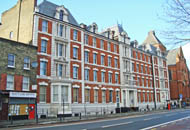
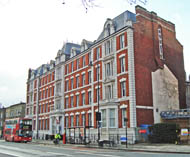
The Kingsland Road frontage from the south (left) and from the north (right).

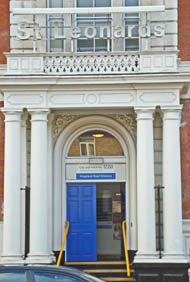
The main entrance in Kingsland Road.

The Hospital name in modern signage, i.e. no apostrophe and no mention of the word 'Hospital' or 'Health Centre'.
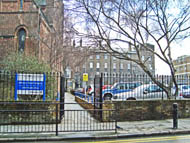


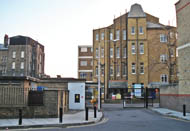
The various Hospital buildings in the rear, seen from the north across Nuttall Street.
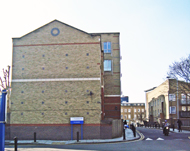
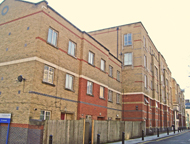
The Mary Seacole Nursing Home in Nuttall Street has replaced the old workhouse buildings.
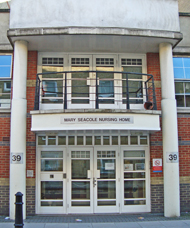
The main entrance to the Mary Seacole Nursing Home.

The Grade I listed St Colomba's Church, built in 1869, was once a slum mission centre with a school and a clergy house. The Hospital, seen on the left, seems dwarfed beside it. The Church is now the headquarters of the Christ Apostolic Church (Bethal) UK.
Other 'lost' hospitals in Hackney are the Hackney, Mothers' Hospital of the Salvation Army, the Eastern and the German, which were replaced by the Homerton Hospital.
http://idox.hackney.gov.uk (1) (accessed January 2010)
http://idox.hackney.gov.uk (2) (accessed January 2010)
www.aim25.ac.uk
www.bartsandthelondon.org.uk
www.geograph.org.uk
www.london-footprints.co.uk
www.nationalarchives.gov.uk
www.parkinsons.org.uk
www.workhouses.org.uk
Return to home page